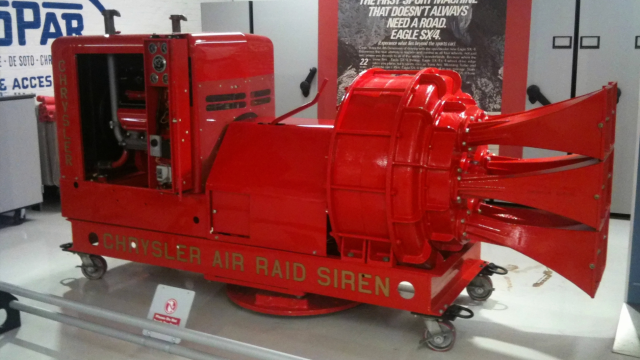I’ve been recently thinking about the last time Americans seemed to have collectively lost their minds: the Cold War. Pondering this time period led me down a YouTube rabbit hole where I learned that during the chilliest portions of the Cold War, Chrysler V8s were used to power the loudest air raid sirens ever built.
I had no idea these existed! And as a nerd who loves both Detroit automotive and Nuclear Age history, I’m a little disappointed in myself. Let’s fix that.
For the first generation, Chrysler and Bell Labs came together to create the Chrysler Bell Victory Siren. The Chrysler-Bell siren had some drawbacks however and a second-generation called the Chrysler Air Raid Siren was born, according to this fascinating article from Autoweek:
While the Chrysler-Bell siren achieved its acoustic goals, its other specs were not quite as advanced: The first production models were manually controlled. A seat was provided, requiring a single brave soul to climb aboard, Slim Pickens-style, rotating until the nuclear flash relieved both man and machine of duty.
Aware of the design’s limitations, a final improved siren was introduced as the Chrysler Air Raid Siren in 1952. Upgrades included the use of the then-new 180-HP (134 kW), 5.4L Chrysler Hemi engine and a three-stage compressor to increase output. The operator’s seat was also gone, replaced by a control panel on the siren’s side allowing dedicated phone lines to activate it. The device was also now even louder, rated at 138 dB at 30.48 m.
The Chrysler Air Raid Siren remains the loudest siren ever produced. Its remarkable specifications include a compressor discharge volume of 73 cubic metres per minute at 7 psi and a residential coverage area of approximately 41 square kilometres. In comparison, the electric sirens commonly used today for tornado and tsunami warnings can alert about 10 square kilometres.
According to company records, approximately 350 Chrysler Air Raid Sirens were built, all by the company’s Marine and Industrial Engine division in Trenton, Mich. A handful remained in service as late as the 1970s, then were scrapped. Some were acquired by museums — including the now-defunct Walter P. Chrysler Museum in Auburn Hills, Mich. — or fell into the hands of ambitious collectors.
The manual siren’s requirement for an operator to ride along as it spat out its wail of impending doom was considered a drawback, but that’s absolutely how I’d want to go out in a nuclear apocalypse. Don’t stick me in some shelter, let me yell at the sky with the loudest thing possible until I’m vaporised.
Some were in use up until the ’70s. Many were scrapped or ended up in museums. Autoweek points out that a few are still mounted in place due to the expense of having the huge machines removed. At least one ended up in the Don Garlits Museum of Drag Racing. In 1997, a British documentary team visiting the museum was treated to cranking up a Chrysler Air Raid Siren. After decades of neglect spent soaking in saltwater spray on a roof in Florida and then languishing in a shop, the ’52 Hemi V8 engine not only started right up but started on gasoline, a fuel that it had never run before as one of the engines outfitted to run on propane.
That’s some quality American craftsmanship.
